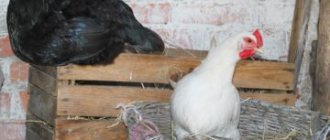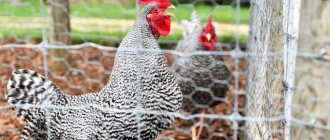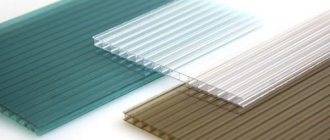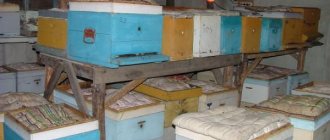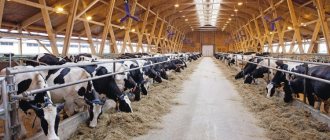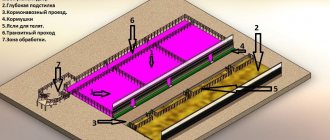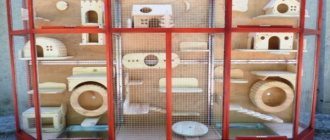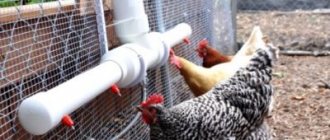Why do chickens need a chicken coop?
Chickens are unpretentious birds. They adapt to different conditions. But do not forget that these are people from southern countries. Therefore, they are unable to winter in open areas.
To provide comfortable conditions for 50 chickens, you will need to build a chicken coop. With this approach, laying hens will begin to supply eggs throughout the year. And broilers will quickly gain weight.
As for the chickens, the poultry house will serve as a comfortable room for their development. A refuge from negative external factors and rodents.
Before you consider how to build chicken coops with your own hands for 50 chickens, you need to familiarize yourself with the rules for its design. Properly carried out preliminary work will guarantee a comfortable stay for chickens and convenient care for them.
Choosing a location on the site
When choosing the location of the chicken coop, you should first pay attention to the landscape. It is not recommended to build housing for birds in low areas, since a lot of moisture collects there and the snow takes longer to melt. This can have a negative impact on the health of the birds. It is best to start construction with a slope to the south. This way, water will not accumulate near the chicken coop - it will be dry and light.
The building must be positioned in such a way that the sun's rays penetrate inside. For example, place a rectangular structure in length from east to west. It is necessary that a sufficient amount of light enters the windows throughout the day, due to which the egg production of chickens will be increased.
Did you know? One chicken can lay 250 to 300 eggs in a year.
Technical design features
Dimensions calculation
The size of the chicken coop depends on the type and number of birds.
When breeding broilers, the optimal option is 3-4 individuals per 1 square meter. m.
Laying hens and meat and egg breeds are more mobile. Therefore, for 1 sq. m will fit 2-3 birds.
Comparing these values, it turns out that the size of a chicken coop for 50 chickens varies between 12.5-16.6 square meters. m.
As for the height, 1.5 meters is enough for chickens. However, it is inconvenient to care for birds. Therefore, it is recommended to make the height of the chicken coop higher than a person’s head.
Drafting
Next, they draw up a design for a chicken coop for 50 chickens. Plan Goals:
- control the work process;
- avoid mistakes during the construction and arrangement of the poultry house;
- monitor the connection of the chicken coop to the electrical network;
- calculate the required amount of building materials.
By considering all the little things at the design stage, you can avoid unnecessary costs of money and your own efforts.
Drawing
The chicken coop plan is drawn with a pencil using a ruler on paper. It is compiled in stages, providing for construction work. Starting from laying the foundation to finishing the room.
The drawing indicates:
- the total area of the building for which construction materials will be calculated;
- size of windows and doors;
- location of openings;
- location of internal equipment;
- ventilation method;
- organization of lighting;
- places for heating devices.
Types of warm chicken coops
A typical room for chickens looks like a barn with an area for walking the birds. The walking area is fenced with a chain-link mesh or similar, which prevents the penetration of cats and dogs, and also allows you to control the location of chickens.
Chicken coops are divided depending on the number of animals:
- 1-15 chickens – a small poultry house, which is designed in the form of a barn with an area of 10-15 m². This space is quite enough for the normal life of the bird. For walking, a place measuring 2x2 m is provided. The structure must also have a window and ventilation;
- 20-30 chickens. Such a room is already a full-fledged barn and has an area of 18-20 m². The height should be about 1.8-2 m, the range should be 2x3 m. A perch of several tiers is built inside and 5-7 nests are installed. If you own a spacious plot of land, you can build a barn with a vestibule, so in winter it will be warmer inside;
- 50 chickens or more. The building measures about 50 m². For such sizes, not only insulation is required, but also additional heating. A shed height of 2 m will also be sufficient. The size of the paddock should be 3x4 m. The number of nests is 7-10, located near the far wall.
The final appearance of the poultry house largely depends not only on the number of birds, but also on the financial capabilities of the owner. For example, a chicken coop can have a closed run, which will prevent the birds from hypothermia in winter and allow them to walk around even in severe frosts.
Do you need a foundation?
A poultry house for 50 chickens is a massive building. To prevent it from collapsing, you need a foundation. A strong supporting structure will also protect birds from rodents and prevent dampness.
For a chicken coop, a simple foundation option is usually chosen. This can be a pile or shallowly buried supporting structure.
When building a chicken coop from cinder blocks and bricks, a strip foundation is suitable. To cultivate a wooden poultry house, a foundation of blocks is selected.
Conditions for winter keeping of birds
The walls are insulated from the outside with mineral wool.
For a comfortable life for birds in winter, it is worth taking care of high-quality insulation of the walls, floor and ceiling. Sometimes the building is sheathed on the outside with foam blocks to prevent wind from penetrating inside. In addition, you need to insulate the door. A woolen curtain is mounted on the inside of it.
In the warm season, the chicken coop needs enough natural lighting, but in winter it is necessary to connect artificial lighting. Ignoring this will have a bad effect on productivity, since the bird lays eggs only during the day or in good light. In a room for 50 heads, it is better to install fluorescent lamps or products with LEDs. The latter, although more expensive, have a long service life and provide high-quality lighting for the chicken coop. Incandescent lamps are a budget option suitable for a small poultry house. They have to be changed frequently.
Floors
There are several ways to build a floor in a chicken coop. Mostly made of gravel, wood or concrete.
The advantages of a dirt floor are almost zero costs. In addition, it is performed simply, without specific knowledge in construction.
Wooden floors have environmentally friendly and thermal insulation properties.
The concrete bottom of the poultry house is considered durable and strong. When choosing such building materials, the risk of rodents entering is reduced.
However, each type has disadvantages. Find out more in the article “What is the best material for making floors in a chicken coop.”
Let's sum it up
You can actually build such a chicken coop, which is necessary for the normal life of laying hens and broilers, with your own hands. By adhering to the fundamental rules, even a novice farmer can master this task. And he can be sure that his work will not pass without a trace. It’s not for nothing that popular wisdom says: “What goes around comes around.”
The more favorable conditions are created for pets, the greater the return in the form of large amounts of meat and eggs that can be obtained. This means that the family will always be provided with tasty and healthy homemade products.
Review of the best wall materials
Introduction
The consumer market provides a variety of raw materials for the construction of small and large buildings.
Let's look at the top materials in demand and their purpose for building a poultry house for 50 chickens.
OSB (OSB) boards
Oriented strand boards, made from fine wood chips, are an affordable material. They are light, durable and aesthetic. Therefore, they are quite suitable for building a summer chicken coop.
For a year-round poultry house, it is better to use OSB boards for interior decoration. And the walls should be built from a different material.
More information in the article “DIY OSB frame chicken coops.”
Building blocks
By using building blocks, construction time can be reduced. Avoid interior decoration. And reduce the load on the foundation. At the same time, they maintain the optimal room temperature, which has a beneficial effect on the life of chickens.
When building a poultry house for 50 birds, it is better to choose foam blocks, tongue-and-groove and polystyrene concrete materials.
The article “DIY foam block chicken coops” will help you make your choice.
Brick
Brick is considered an excellent solution for building the walls of a chicken coop for 50 birds. Its advantages include durability. With proper construction, a capital building will last for decades.
Brick walls do not require annual repairs.
A brick chicken coop will provide reliable protection for birds from predators.
There are also disadvantages. Building with brick will cost more than building with other building materials. Long construction period. A brick outbuilding for 50 chickens requires careful insulation.
In this case, the construction of the walls of the chicken coop is carried out using special technology. Therefore, without knowledge and experience in construction, it is better to give preference to another material.
Tree
It is considered a common material for building chicken coop walls. With proper processing of the beams, the design is practical, comfortable and durable.
In addition, wood is highly environmentally friendly and economical. Wooden walls fit into any landscape design. Therefore, when choosing this material, you can ensure a comfortable life for chickens. And emphasize the style of the personal plot.
Shell rock
A distinctive feature is high environmental friendliness and low thermal conductivity. Shell rock is produced in blocks of 180x180x380 cm.
Materials and tools
The reliability and durability of a building depend on high-quality materials. The most common raw material for building a chicken coop is wood. At the moment, OSB (oriented strand tiles) can be considered the most easily accessible, durable and in demand. Working with this material is easy even with no experience.
For construction, you can also use brick, expanded clay and concrete blocks. It is not worth using sheet iron, since it does not retain heat, but, on the contrary, attracts dampness, moisture and cold, which will have a bad effect on the health of chickens.
You will need the following materials and tools for construction:
- cement - two bags;
- sand;
- concrete mixer or container for mixing cement mortar;
- nails, screws;
- hammer, drill, saw and cord;
- building level;
- insulation (expanded clay);
- slate and roofing felt;
- light bulb, electrical wire, switch;
- glass;
- boards, beams, bars;
- concrete blocks;
- Rabitz;
- pipe for ventilation;
- shovel, trowel;
- roulette;
- metal grid;
- crushed stone;
- spatula and grater.
We recommend that you read how to disinfect a chicken coop.
General principles of construction
Selecting a location
It is recommended to locate a poultry house for 50 chickens in elevated areas with deep groundwater. In this case, the future house will not be flooded during heavy rains.
When choosing a location, you need to take into account that the birds need an aviary for walking. Therefore, the construction site must be extensive.
Chickens' productivity decreases when there are extraneous sounds. In this regard, it is advisable to place the chicken coop inside the yard, away from roads and other sources of strong noise.
Construction equipment
As practice has shown, more often the chicken coop is made of natural wood. Therefore, you need to stock up on the required number of boards and beams. To fill the foundation, several bags of cement and brick raw materials are purchased.
The construction equipment includes:
- nails;
- self-tapping screws;
- hammer;
- axe;
- shovel;
- ruler;
- pencil;
- level.
Let's figure out how to build a chicken coop with your own hands for 50 chickens step by step.
Construction of the foundation
Construction begins with the organization of the foundation. For a chicken coop for 50 chickens, it is better to create it in the form of pillars.
Let's consider the sequence of foundation construction.
The chicken coop project is transferred to the construction site.
Metal rods are driven into the areas of the ground where the corners of the poultry house will be located. Connected with durable tape. Inside the fenced area, 20 cm of soil is removed.
Along the perimeter, at a distance of 1 m from each other, pedestals with a height of 30 cm are organized.
In order to protect against rodents and for structural strength, the resulting earthen holes with pedestals are first filled with broken glass and bricks. And then they are filled with cement.
After the foundation has completely dried, freeing the cement pillars, they begin to build the wooden floor.
Walls
You can build a poultry house frame for 50 chickens from beams and logs. But you need to take into account that wooden walls shrink. Therefore, they should be built with a margin of 3-5% of the design height of the poultry house. A gap of 5% of their height is left above all openings, posts and jambs.
Between the first row of beams and the foundation, waterproofing made of roofing felt or roofing felt is laid. Next, each block is stacked on top of each other with alternating tow. The wood is fastened horizontally with dowels, in a checkerboard pattern.
In order to protect against freezing, the corners in the cobblestone walls are first caulked. And then they are covered with plank pilasters. They are installed strictly after the walls shrink.
Installation of doors and windows
Window and door frames are installed during the construction of walls. Installation is carried out using waterproofing foam.
Upon completion of the frame construction, hinges or hinges are attached to the doorway. Then the door is hung on them. And the windows are inserted into window boxes.
Roof assembly
Consider the manufacture of a gable roof.
Rafters are attached to the wall frame. A waterproofing film is laid on them. The sheathing is placed on top.
At the end of the work, the roofing covering is laid on the sheathing.
Organization of a walking pen
An aviary for walking chickens is built on the south side of the chicken coop. Chain-link mesh is used as fencing. For laying hens - 2 m high. For broilers - 1.8 m.
The size of the run and other nuances can be found in the article “Building a pen for chickens with your own hands.”
Insulation
The temperature of the poultry house should not be allowed to drop to 0 degrees in winter. Otherwise, the chickens will stop laying eggs and gain body weight.
The chicken coop is insulated along the entire perimeter, starting from the base and ending with the roof. Various materials can be used as insulation: peat moss, sawdust, straw, tow.
Details in the article “How to insulate a chicken coop for the winter with your own hands.”
Ventilation
A poultry house for 50 chickens must have ventilation. With proper air exchange you can:
- provide the chicken with the required volume of clean air;
- eliminate ammonia vapors, which smell bad and negatively affect the health of birds;
- regulate temperature;
- set the desired air humidity parameter.
For natural air exchange, a supply and exhaust system is provided at the construction stage. The air duct is installed under the ceiling and leads out onto the street above the roof ridge.
For forced ventilation, sensors are installed inside the chicken coop. This system is equipped with electric fans. They start on their own, if necessary, to remove bad air.
Lighting
When there is a lack of light, chickens usually stop moving actively and fall asleep. At the same time, their productivity decreases. To prevent this, it is recommended to organize lighting for the poultry house. It can be of two types.
Continuous lighting: during daylight hours, one block of the poultry house is in the dark.
Intermittent lighting: When there is daylight, there are 2 to 4 blocks of darkness.
Lighting lamps are placed at a sufficient height. So that they do not interfere while caring for chickens. And they were easy to replace. They must be protected from moisture and other negative factors by shades or caps.
Internal equipment
The interior arrangement of the chicken coop is done so that the birds can live comfortably. And it is convenient for farmers to care for them.
Let's figure out what the poultry house equipment includes.
Perches: these are round or oval bars that are installed at a certain height above the floor. On average, 20-25 cm of perch length is allocated for one chicken.
Nests: to prevent chickens from laying on the floor and pecking at eggs, special nesting boxes are built for them. According to the norms, one nest is installed for 3 chickens.
Drinkers and feeders should be located inside the poultry house and in the aviary. The best option for 50 chickens is bunker feeders. Drinkers are constructed so that chickens cannot turn them over and clog the water with dirt.
If the chicken coop involves keeping chickens, it is recommended to make special cages.
In continuation of these topics, we advise you to read the article “Rules and tricks for arranging a chicken coop inside.”
Interior arrangement
Building a poultry house is not enough; the interior design plays an important role when keeping chickens. Three points deserve attention: lighting, ventilation, heating.
Lighting
The optimal duration of illumination is considered to be 14 hours, the intensity depends on the zone and is 5-15 or 60 Lux (this information is presented in the design requirements section).
Advice! The organization of lighting with red light will help to eliminate anxiety and excitability of chickens and pecking.
Various lamps are used to organize lighting; a brief description of each type will help you make a choice:
- Incandescent lamps. The relative cheapness is overshadowed by rapid failure. Suitable for small chicken coops, used as a point source of heat.
- Fluorescent lamps. Energy-saving properties coupled with durability are the main advantages of the solution when arranging a chicken coop for chickens. A poultry house for 50 birds can be equipped with a similar source, but in large-scale production this type of lighting has already been abandoned. The flickering of low-quality lamps negatively affects the condition of the chickens in the chicken coop.
- LED bulbs. Optimally suitable for arranging lighting in poultry houses. The apparent high cost of the products quickly pays off. The advantages of choosing are a spectral range suitable for chickens, the ability to adjust the intensity of lighting in the chicken coop, low energy consumption and simple maintenance.
A do-it-yourself winter chicken coop for 50 chickens is shown in the photo below:
Ventilation
Setting up a poultry house is not complete without proper ventilation. It is recommended to use a system of supply and exhaust pipes, which is characterized by high efficiency. To do this you will need:
- Two pipes Ø 150-200 mm, 2 and 0.5 m long.
- A long supply pipe is fixed above the floor at a level of 0.2 m in a vertical position. Its upper edge will be under the roof.
- The outlet pipe is also fixed vertically so that about 10 cm remains inside the chicken coop, the rest will be outside the house.
This design provides pressure in the pipes, due to which fresh air flows inside the chicken coop, and ammonia fumes, excess moisture and carbon dioxide are removed outside.
Heating options
Setting up a poultry house requires taking care of the heat in the chicken coop during the winter. The minimum temperature for normal life of chickens is +12°C, otherwise feed consumption will increase against the backdrop of decreased productivity and the development of poultry diseases.
There are several ways to organize heat in a chicken coop:
- Natural insulation. Suitable for a poultry house if winter cold in the region does not exceed -10°C. For this purpose, sawdust can be used, which is distributed over the floor of the chicken coop in a layer of 10-15 cm and is periodically topped up as it is compacted. A more severe climate requires you to take care of forced heating in the chicken coop.
- Electric heating. Heating in the chicken coop can be arranged using electric heaters. This includes air heaters, oil-fired appliances, fan heaters and convectors. You can create the desired temperature in the poultry house for chickens during the cold season by using infrared floor film. An effective option for arranging heating would be to install infrared heaters in a chicken coop.
- Gas equipment. For a poultry house designed to raise 50 chickens, this is considered an irrational heating method.
- Stove heating. Despite its high efficiency, the use of this method is inappropriate due to the risk of fire in the poultry house.
- Water heating. The option is effective, but its implementation is possible only if the chicken coop is built in close proximity to the house.
- Diesel stove. An effective and safe method of heating a poultry house is characterized by high energy intensity.
An analysis of all the proposed methods for arranging heating in a chicken coop allows us to draw a conclusion about the optimal use of infrared film or lamps for these purposes.
Rules for keeping a chicken coop for 50 birds
Basics
If there are a large number of chickens in one chicken coop, infectious diseases may appear, leading to the death of the livestock. Preventive work will help protect birds from diseases and parasites.
The set of measures includes cleaning the premises. It is recommended to clean the poultry house from droppings, dampness and food debris daily. The litter is changed as needed.
Sanitation of the chicken coop is carried out at certain intervals. The optimal interval between disinfections is 2 months.
Additional
Providing chickens with fresh air is carried out daily. At the same time, drafts should not be allowed during ventilation of the room.
According to sanitary and hygienic standards, chicken coop care should include wet cleaning. During this process, the entire area of the premises is thoroughly washed, including feeders, drinking bowls and perches.
If you have experience in building large chicken coops, please share in the comments with our readers. Perhaps your advice will help beginners avoid irreparable mistakes.
Please share the article on social networks. This way you can track reviews and learn new nuances in the construction of poultry houses. Special thanks to everyone for 5 stars.
Instructions for beginner builders
Of course, to obtain more detailed information about the construction algorithm, it would be better to refer to photos and videos on the Internet, which clearly describe the entire process.
The main stages can be reduced to an elementary plan.
- Pouring the foundation. Mark the area of the future chicken coop, dig a hole at least 50 cm deep and fill it with a solution of sand, cement and crushed stone. When the foundation is dry, cover it with roofing felt and lay the first layer of timber.
- Preparing the floor. Using logs installed with edges every 1 meter and boards, prepare the base of the poultry house floor, cover it with waterproofing and vapor barrier, and add insulation to the free space.
- Forcing walls. Lay the beams on top of each other, interlock and drive in dowels every meter to a depth of 6-7 cm. Treat the walls with plaster or plywood. Insulate the walls by filling all cracks with polystyrene foam. After completion of the work, the walls should be between 25 and 50 cm thick.
- Cover the building with a roof. To do this, install additional boards and beams, lay everything with expanded clay, lay out the final boards and cover them first with roofing felt, and only then with slate.
- Insert doors and windows into the room.
After all the basic work is completed, proceed to the interior arrangement. Install nests and perches for chickens. Find a photo or video of their correct construction. Choose a place to feed the birds. The final stage of construction involves fencing the enclosure for chicken walks. Experienced poultry farmers recommend combining it with the size of the main room. It is easy to do with the help of high nets so that the bird does not try to fly away.
How to make a mini chicken coop: step-by-step instructions
Preparing boards for the frame consists of cutting them to the required length. If the house moves, the supporting beams are equipped with wheels at the bottom. A frame for prefabricated panels is assembled from timber:
- rectangular - for the sides of the house;
- a rectangle with a lathing inside - for installing chicken nests;
- on one side a contour is made for installing a door, and on the other - for installing a window.
Fastening with self-tapping screws is carried out from the outside so that it is easy to access them if necessary.
House assembly:
- At the site on which the house is installed, a layer of soil is removed and it is covered with crushed stone and sand.
- The frame of the house is assembled on the site.
- The structure will stand on legs, possibly with wheels.
- The floor frame (frame) can be raised to a height of 15 to 30 cm above the platform.
- The floor is sheathed with boards in 2 layers with insulation laid.
- The walls are covered with sandwich panels.
- Doors on hinges are installed in the doorway (large ones for the owners to enter and small ones for the chickens to exit into the enclosure).
- The window is being installed.
- The roof is made of the same sandwich panels and covered with roofing material.
- Sections for the enclosure are made from a wooden frame and mesh.
- The aviary is fixed next to the house.
- Nests, a vacuum drinker and feeders are installed inside the poultry house, and a perch is mounted.
We recommend that you read the step-by-step instructions for building a chicken coop for 30 and 50 chickens.
Video: DIY mini chicken coop
If the house is monolithic, then the foundation is prepared:
- a trench is dug, formwork is done and concrete is poured;
- or make a trench and install a columnar foundation.
If you create a floor from fine mesh and install a tray down, it will be easier to clean it from droppings. The roof must be single or gable so that rainwater or snow does not accumulate on its surface.
Important! Sandwich panels are a multilayer material for the construction of quickly assembled structures. Developed in 1930
Can be roofing or wall.
DIY winter chicken coop for 20 chickens
Here the principles of construction and the sequence of actions are similar to the previous version. You just need to make allowances for a larger number of inhabitants and select the appropriate drawings. Typically, for 20 birds, taking into account the placement of nesting boxes, drinking bowls, feeders and other equipment, 15...20 square meters are required.
The presented option has an attached paddock for walking and a small porch. The roof is not shown in the diagram, but is gable with the ridge located along the long axis of the rectangular structure.
When determining the height of the roof and, accordingly, the overall proportions of the building, it is necessary to take into account the standard dimensions of the internal elements of the chicken coop.
These dimensions are determined based on the size and breed of birds. If the chickens are very small or, on the contrary, very large, it is worth adjusting the nuances of arranging the chicken coop inside accordingly.
If desired, such a building can be insulated not only on a permanent basis (with mineral wool in the frame cells), but also additionally by storing straw and hay under a canopy next to the wall. This is worth doing if there are other consumers of this agricultural product on the farm.
The same straw is used for flooring in winter - it provides both insulation and comfortable bedding for birds. Pre-disinfect the floor with lime.
Features of a portable chicken coop
To begin with, let’s note all the advantages of a portable bird house:
1. Chickens will be able to find their own food without leaving their new home, and you can reduce the amount of feed they consume.
2. Due to the small size of the structure, it will be much easier to clean, and the birds will not have to change the bedding at all.
3. A mobile chicken coop gives a head start to a stationary poultry house for the reason that it combines limited space and the ability to “walk” chickens in any convenient place on the site, for example, depending on weather conditions.
Remember that the capacity of a portable chicken coop is limited, and its size directly depends on the number of birds you plan to house there.
How to make a small chicken coop
A mini-chicken coop can look like a cage. The dimensions of the cage for several chickens are 1x2 m. It does not need a foundation; it is placed on the grass.
A mini chicken coop for 5 chickens can be made in the form of a cage
Tools and materials for manufacturing:
- timber 50x50 mm;
- nails and screws;
- Rabitz;
- wooden slats 20x30 mm;
- iron pipes;
- door hinges;
- plywood sheets;
- tiles or slate;
- insulation material;
- hammer;
- saw;
- electric drill or screwdriver.
You need to make a drawing first
It is important to determine which side the windows and entrance will be located on. This will allow you to choose a place for perches and nests (in the far corner)
The drawing must indicate the location of all devices, as well as the dimensions of the poultry house.
Sequence of work:
- Cut blanks from beams and plywood sheets 1 m long, 2 m wide and 0.7 m high (for the frame and walls).
- Fasten the elements together with bolts. On the left side you need to place a small door for the chickens to exit. In the front there is a large door, which is necessary for cleaning and access to the nests.
- Sheathe the frame from the inside with a plywood sheet or OSB board (place it on screws).
- Attach insulating material to the walls, sheathe the frame from the outside, and paint it.
- Make the legs 60–70 cm high.
- Place transverse strips on the roof, insulate it and cover it with roofing material. Line the roof from the inside with plywood.
- The dimensions of the walk are 2 times larger than the house. Drive in the rods, tighten the mesh and secure it.
- The outermost parts of the mesh should be tightly adjacent to the house so that the birds cannot escape.
Preparatory stage
You can create a chicken coop for 50 chickens with your own hands. You don't need any special skills to do this. Before work, you should indicate the procedure:
- find sufficient area for construction;
- select and prepare building materials - you can also use improvised means, buy what you need;
- decide on the project;
- prepare a strong foundation;
- build the walls, floor, ceiling and roof of the poultry house;
- carry out finishing work and move residents into the house.
Setting up a chicken coop inside
In addition to the outer wooden frame on the foundation, the chicken coop needs additional equipment with perches, nests, feeding areas, and must also be cleaned daily.
Perches
They are placed both in one room with nests and in separate ones. They are thin poles placed in two or more rows like a ladder. Designed for comfortable placement of birds in the chicken coop. To choose a roost suitable for your chicken coop, focus on the number of birds in the room and the difference in their height.
For a homogeneous population, choose multi-level perches; for birds of different ages and strengths, purchase single-level lattice and pallet perches.
Learn how to make your own chicken perches.
Nests
There are open and closed types. Closed models are better suited for young, restless birds; for adult laying hens, you can limit yourself to open nests. The linear dimensions of the nest must be at least 35x50 cm. The number of nests is calculated in this way: the population is divided into two. Therefore, for a chicken coop for 20 birds, 10 nests will be enough.
Feeders and drinkers
Feeders differ from each other in the material of manufacture and are:
- plastic;
- wooden;
- made of ergoglass.
Important! If you plan to feed young animals, install tray feeders for them. They are stable, and the feed from them is not scattered during feeding. They are also divided according to the type of feed distribution into:
They are also divided according to the type of feed distribution into:
- tray;
- grooved (automatic);
- bunkers.
There are drinking bowls:
- nipple (automatic);
- cup;
- ordinary capacitive ones.
Choose drinkers and feeders based on the age of the livestock and its number. On large farms it makes sense to use automatic installations, as well as in herds of young animals.
Litter
It is used mainly in the cold season to prevent birds' paws from freezing and their colds. It is poured in a layer of 5–7 cm, and then trampled down by the birds themselves and at the same time mixed with droppings. Peat or clean dry sawdust, which is highly hygroscopic, is used as bedding.
It will also be helpful for you to know what kind of bedding to use for your chickens.
In the warm season, it is not necessary to use litter - it is permissible to pour a thin layer up to 1 cm deep, followed by cleaning it out of the chicken coop once every two days.
Walking yard
A run yard is used to release chickens from the main area of the chicken coop so that they can graze freely. The size of the yard varies from 1.5 m to 1.8 m. It is fenced with a metal mesh without defects so that predators cannot get into the chicken coop.
The chicken coop itself should have a separate door leading to the walking yard. A canopy is often placed over it to protect the livestock. And on the territory of the courtyard they place perches.
Chickens are the source of the most popular meat and fresh eggs. In order for keeping poultry to be beneficial, the owner of the yard must take care of the comfort, health and safety of his bird population.
Active link to the source - be sure to look at the information from the original source fermer.blog
Winter insulation of the room
Winter insulation of the chicken coop must be taken care of in advance. A warm chicken coop means healthy chickens. The egg production and vital activity of birds depends on the quality of insulation both outside and inside.
In cold weather, insulation is added to the chickens' home on all walls, windows, doors, floors and roofs. Most often, only windows and doors are insulated. To make the walls comfortable for birds to stay in in winter, the outside of the chicken coop is lined with foam blocks. This material retains heat and prevents wind from entering the room.
Find out how to insulate a chicken coop for the winter.
Sometimes the walls are covered with shingles and plaster is applied on top. This is also an effective insulation method. Windows are covered with plastic film for the winter. The doors are also insulated with film, adding a woolen curtain to it. In the roof, the empty space between the ceiling and the attic is filled with expanded clay to retain heat, and thermal insulation is provided during construction.
